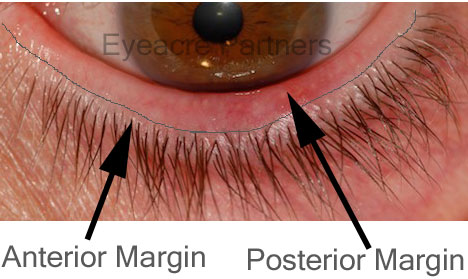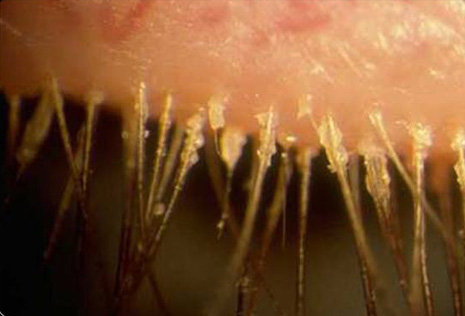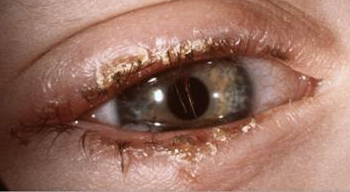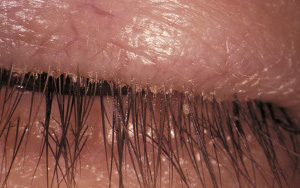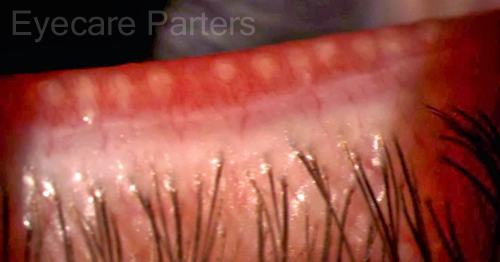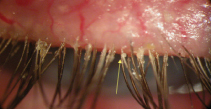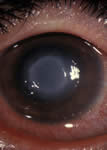| Blepharitis: What Type do You Have?12 October 2014 | Eyecare Partners Many people have been told that they suffer from blepharitis, which is a condition which affects the eyelids, causing soreness, redness, crusting and swelling of the lid margin. It is a very common cause of red, burning, dry, watery, gritty eyes and contributes to infections such as repeated lid styes and cysts. Some types of blepharitis are curable, but many cases are chronic (long term) and incurable and requires on-going treatment. Effective treatment depends on using the correct products for the type of blepharitis you have. Blepharitis is classified according to
Location of Area Affected : Anterior or Posterior Lid Margin
When the inflammation mainly affects the outer 'skin side' edge of the eyelids, where the eyelashes are attached, it is called Anterior Blepharitis as it is the front edge of the lid margin that is inflamed. When the inflammation mainly affects the inner edge of the eyelid that comes in contact with the eyeball it is called Posterior Blepharitis. Most people will predominantly have one of the two types but some will have a mixture of both. The cause of the blepharitis usually determines whether it is the Anterior or Posterior lid margin that is affected. Anterior Blepharitis is usually due to bacteria or a seborrhoeic disorder. Posterior Blepharitis: this is usually due to Meibomian Gland Dysfuntion (MGD) Types of Blepharitis: Bacterial, Ulcerative Seborrhoeic, MGD, ParasiticBacterial Blepharitis:Common bacteria that live naturally on the skin such as staphylococcal aureus or staphylococcal epidermis are responsible for about 30% of blepharitis cases. The bacteria either cause direct infection or they indirectly cause inflammation via the eyelids reacting to the toxins that the bacteria produce or being allergic to the bacteria.
Blepharitis due to bacteria is usually of a simple 'non-ulcerative' form, in which there is crusting around the base of the eye lashes, redness and swelling but no open sores.
Ulcerative Blepharitis:This is a more severe, less common type in which there are also open sores (small ulcers) along the lid margin that ooze and bleed. There may also be a loss or mis-direction of eyelashes, irregular thickening of the lid margin and chronic watering of the eye. In severe cases, the cornea, may also become inflamed and infected.
Ulcerative blepharitis is usually caused by bacteria and can be as part of a chronic blepharitis which flares up suddenly and acutely from time to time. Less commonly it can also be due to viruses such as Herpes Simplex (the same virus that causes cold sores) or Varicella Zoster Virus (the same virus that causes chicken pox). Seborrhoeic Blepharitis:This type of blepharitis results from a dysfunction of the oil glands that are connected to hair and lash follicles. The glands produce sebum, a type of oil. In Seborrhoeic Blepharitis the glands produce excessive sebum, resulting in the accumulation of 'dandruff-like' flakes along the lashes and lid margins.
Seborrhoeic Blepharitis is thought to be caused by a yeast fungus, Malassezia Furfur, which lives near hair follicles. The condition is not contagious. Seborrhoeic blepharitis is closely associated with a skin condition called seborrhoeic dermatitis. In seborrhoeic dermatitis, the affected skin becomes more oily and can become scaly. Seborrhoeic dermatitis typically causes bad dandruff and sometimes a rash, commonly on the face and upper body. MGD Blepharitis:This is a very common type of blepharitis that results from Meibomian Gland Dysfunction. The Meibomian Glands are a set of glands in the upper and lower eyelids that produce oil for the tear film. The oil that is produced is usually a clear runny oil that seeps out through openings in the lid margin.
For reasons not fully understood, inflammation occurs in the glands causing production of thickened poor quality oil that doesn't easily seep in to the tear film and causes blockages in the ducts and openings of the eyelids and margins. The condition is a cycle, with inflammation producing further inflammation, which results in further damage to the lids and eyes. Meibomian Gland Dysfunction is more common as we age, but is also associated with other skin conditions such as Rosacea. Parasitic Blepharitis:
This is inflammation caused by two common parasites, demodex brevix and demodex follicularum. They live in hair and eyelash follicles and in the meibomian glands. Signs include redness of the lid margins and cylindrical scaling around the lashes. Blepharitis due to parasitic causes is particularly common in those aged over fifty. |
| ||||||||
